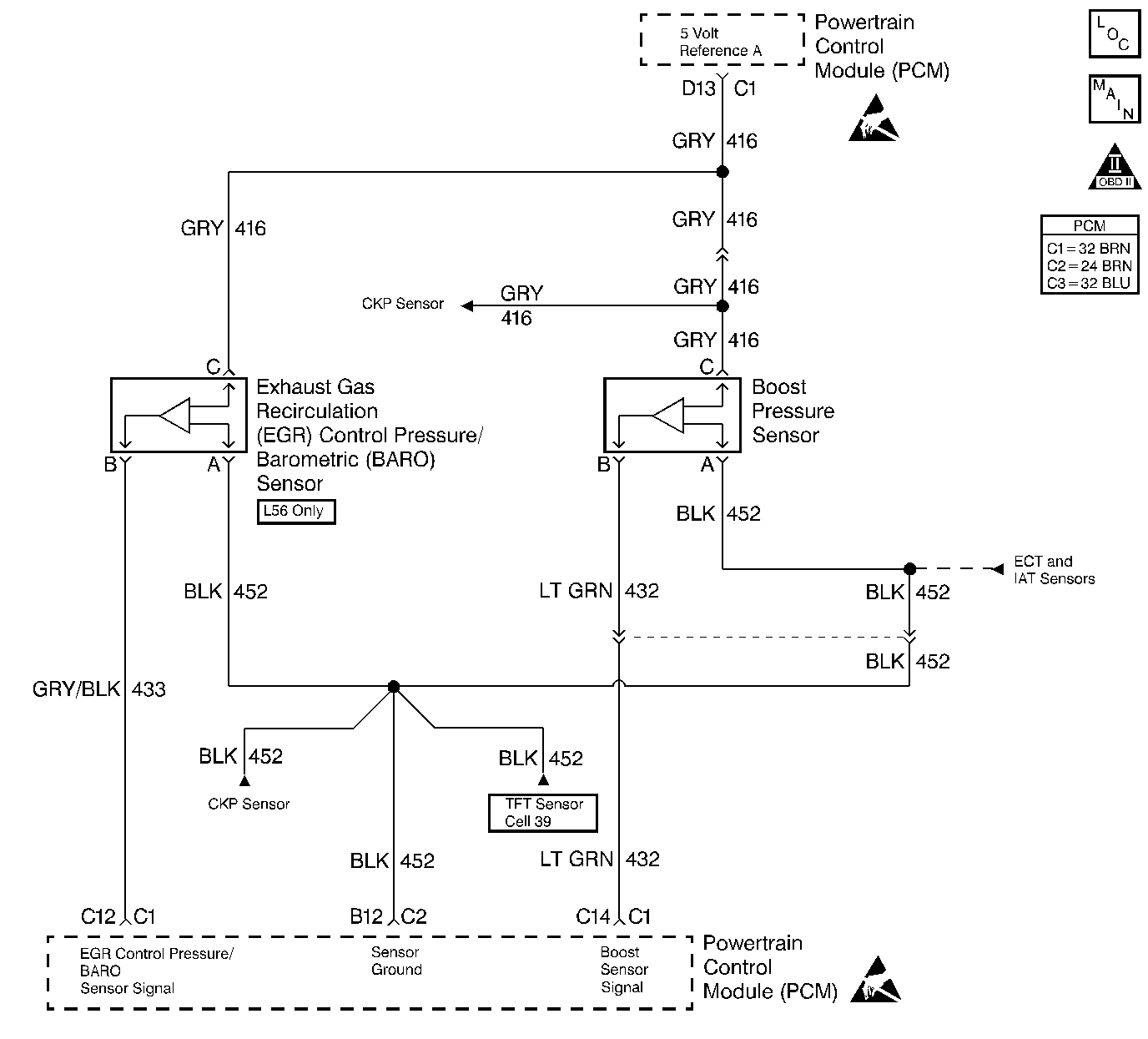
Refer to Emission Hose Routing Diagram
Circuit Description
An EGR control pressure/baro sensor is used to monitor the amount of vacuum in the EGR circuit. It senses the actual vacuum in the EGR vacuum line and sends a signal back to the PCM. This signal is used to control EGR duty cycle calculated by the PCM.
Conditions for Running the DTC
| • | The PCM performs this DTC diagnostic continuously. |
| • | The ignition switch in the ON position. |
Conditions for Setting the DTC
| • | The EGR control pressure signal is less than 0.24 volts (15 kPa). |
| • | All diagnostic set conditions met for 2 seconds. |
Action Taken When the DTC Sets
| • | The PCM will shut down the EGR. |
| • | The PCM illuminates the malfunction indicator lamp (MIL) on the second consecutive drive trip that the diagnostic runs and fails. |
| • | The PCM records the operating conditions at the time the diagnostic fails. The first time the diagnostic fails, the Failure Records will store this information. If the diagnostic reports a failure on the second consecutive drive trip, the Freeze Frame records the operating conditions at the time of failure and updates the Failure Records. |
Conditions for Clearing the MIL/DTC
| • | The PCM will turn the MIL off after three consecutive trips without a fault condition. |
| • | A History DTC clears after forty consecutive warm-up cycles, if this or any other emission related diagnostic does not report any failures |
| • | The use of a scan tool. |
Diagnostic Aids
With the ignition ON and the engine OFF, the EGR pressure is equal to atmospheric pressure with the signal voltage being high.
The Adaptive Learn Matrix (ALM) is used to adjust the EGR vacuum control based on mass air flow (MAF). The ALM may change as a result of back pressure increases over the life of the vehicle or other engine system variations. The ALM is made up of sixteen cells (numbered from zero to fifteen) in which each cell covers a range of engine speed (RPM) and load (mm3).
Test Description
Number(s) below refer to the step number(s) on the Diagnostic Table.
-
This step determines if P0405 is a hard failure or an intermittent condition.
-
Jumpering the 5 volt reference circuit to the signal circuit will determine if the sensor is at fault, or if there is a problem with the PCM or wiring.
-
The scan tool may not display 5 volts. The important thing is that the PCM recognized the voltage as more than 4 volts, indicating that the PCM and the signal circuit are OK.
Step | Action | Value(s) | Yes | No |
|---|---|---|---|---|
1 |
Important: Before clearing any DTCs, use the scan tool Capture Info to save freeze frame and failure records for reference, as the Scan tool loses data when using the Clear Info function. Was the Powertrain On-Board Diagnostic (OBD) system check performed? | -- | ||
2 |
Does the scan tool display EGR Sensor less than or equal to the specified value? | 0.24 V | ||
3 |
Does the scan tool display the EGR Sensor voltage greater than the specified value? | 4.0 V | ||
4 |
Does the scan tool display the EGR Sensor voltage greater than the specified value? | 4.0 V | ||
5 | The DTC is intermittent. If no additional DTCs are stored, refer to Diagnostic Aids. If additional DTCs are stored refer to those table(s) first. Are any additional DTCs stored? | -- | Go to the Applicable DTC Table | Go to Diagnostic Aids |
6 | Check for a proper connection at the EGR Control pressure/BARO sensor Was a problem found? | -- | ||
7 | Check for an open EGR Control pressure/BARO sensor signal circuit. Was a problem found? | -- | ||
8 | Check the EGR Control pressure/BARO sensor signal circuit for a short to ground. Was a problem found? | -- | ||
9 | Check for an open in the EGR Control pressure/BARO sensor 5 volt reference circuit. Was a problem found? | -- | ||
10 | Check for a short to ground in the EGR Control pressure/BARO sensor 5 volt reference circuit. Was a problem found? | -- | ||
11 | Replace the EGR Control pressure/BARO sensor. Refer to Exhaust Gas Recirculation Control Pressure Sensor Replacement . Is the action complete? | -- | -- | |
12 | Repair the circuit as necessary. Is the action complete? | -- | -- | |
13 | Replace the PCM. Important: The new PCM must be programmed. Refer to Powertrain Control Module Replacement/Programming . Is the action complete? | -- | -- | |
14 |
Important: After Repairs, the EGR ALM cells must be reset (under special functions in scan tool). Are EGR ALM cells reset? | -- | -- | |
15 |
Does the Scan Tool indicate the diagnostic Passed? | -- | ||
16 | Does the Scan tool display any additional undiagnosed DTCs? | -- | Go to the Applicable DTC Table | System OK |
